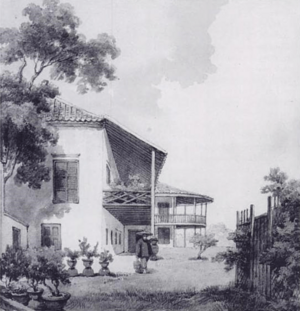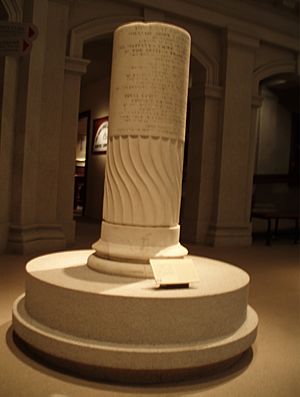William Napier, 9th Lord Napier facts for kids
Quick facts for kids
The Lord Napier
|
|
|---|---|
 |
|
| Chief Superintendent of British Trade in China | |
| In office 31 December 1833 – 11 October 1834 |
|
| Preceded by | Position created |
| Succeeded by | John Francis Davis |
| Personal details | |
| Born | 13 October 1786 Kinsale, Ireland |
| Died | 11 October 1834 Macau |
| Spouse | Elizabeth Cochrane-Johnstone |
| Profession | Naval officer, trade envoy |
William John Napier, 9th Lord Napier (born October 13, 1786 – died October 11, 1834) was an important British figure. He served as an officer in the Royal Navy, which is the United Kingdom's navy. Later, he became a special representative for British trade in China. He was known as the first Chief Superintendent of British Trade in China.
Contents
Where Was Lord Napier Born?
William John Napier was born in a place called Kinsale, in Ireland, on October 13, 1786. His father was Francis Napier, 8th Lord Napier. William later became the father of Francis Napier, 10th Lord Napier, who also had an important career.
In 1803, when he was about 17, Napier joined the Royal Navy. He quickly showed great skill. He served as a midshipman, which is a junior officer, on a ship called HMS Defiance. He fought bravely in a famous battle called the Battle of Trafalgar in 1805. After that, he became a lieutenant and worked under a well-known naval officer, Thomas Cochrane, 10th Earl of Dundonald.
Role as Trade Superintendent
Becoming a Scottish Peer
Lord Napier was a peer of Scotland. This meant he held a special title. From 1824 to 1832, he was chosen to represent Scotland in the House of Lords. This is part of the British Parliament.
New Role in China
In December 1833, a big change happened. The British East India Company had been the only British company allowed to trade in the Far East. But this special right, called a monopoly, ended. Because of this, the British government wanted to expand trade.
The Foreign Secretary, Lord Palmerston, who was a friend of Napier's family, chose Lord Napier for a new job. He became the first Chief Superintendent of Trade at Canton. Canton is now known as Guangzhou in China. His main goal was to open up more trade for Britain deeper inside China.
Arrival in China
Lord Napier arrived in Macau on July 15, 1834. He traveled on a ship called Andromanche. Ten days later, he reached Canton. However, he didn't have much experience in diplomacy or international business. This made it hard for him to succeed in his mission.
Challenges and Conflict
Lord Napier faced many difficulties in China. He tried to meet with Lu Kun, who was the Governor-general of the Liangguang region. But Napier insisted on doing things his own way, which went against the long-standing rules and customs of China. Because of this, he could not get a meeting.
Napier became very frustrated. He decided to use military force. On September 11, he sent two British warships, Andromache and Imogene, to Whampoa. This was against Lu Kun's orders. The British ships fired cannons as they passed through the defenses at the Bocca Tigris. Luckily, no one was hurt in this small fight.
Napier's Illness and Death
After a long standoff, Lord Napier became very sick with typhus fever. In September 1834, he had to leave Canton and go back to Macau. He died there on October 11, 1834. He was first buried in Macau, but later his body was moved to Ettrick in Scotland.
Idea for Hong Kong
Lord Napier was the first British official to suggest taking control of Hong Kong. On August 14, 1834, he sent a message to Lord Palmerston. He suggested that Britain should make a trade agreement with China. He believed this agreement should be supported by military force. This would help protect the rights of European traders in China. He also thought a small British force should "take possession of the Island of Hongkong." He believed Hong Kong was perfect for many purposes.
Family Life
Lord Napier married Elizabeth Cochrane-Johnstone in 1816. She was the daughter of a Scottish adventurer named Andrew Cochrane-Johnstone. They had two sons and six daughters. Their oldest son, Francis Napier, 10th Lord Napier, also became a diplomat. Lord Palmerston helped him throughout his career.
Honours and Memorials
About 120 years after Lord Napier's death, the British Government placed a memorial for him. It was put in front of the Macao Customs Office. For a short time, it was lost. Then, it was moved to the Hong Kong Cemetery. Today, it rests at the Hong Kong Museum of History.



